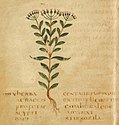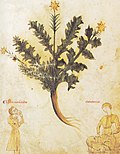Pseudo-Apuleius

Pseudo-Apuleius is the name given in modern scholarship to the author of a 4th-century herbal known as Pseudo-Apuleius Herbarius or Herbarium Apuleii Platonici. The author of the text apparently wished readers to think that it was by Apuleius of Madaura (124–170 CE), the Roman poet and philosopher, but modern scholars do not believe this attribution. Little or nothing else is known of Pseudo-Apuleius.
The oldest surviving manuscript of the Herbarium is the 6th-century Leiden, MS. Voss. Q.9. Until the 12th century it was the most influential herbal in Europe, with numerous extant copies surviving into the modern era, along with several copies of an Old English translation. Thereafter, it was more or less displaced by the Circa instans, a herbal produced at the school of Salerno. "Pseudo-Apuleius" is also used as a shorthand generic term to refer to the manuscripts and derived works.
Pseudo-Apuleius Herbarius
Illustrations
- Manuscr. Leiden 6th cent Arnoglossa, Plantago
- Manuscr. Leiden 6th cent Dragontea
- Manuscr. Leiden 6th cent Centauria maior
- Manuscr. Leiden 6th cent Centauria minor
- Manuscr. Leiden 6th cent Caelidonia
- Manuscr. Leiden 6th cent Nymp[h]ea
- Cod. Vind. 93 13th cent. Arnoglossa. Plantago
- Cod. Vind. 93 13th cent. Drag[on]tea
- Cod. Vind. 93 13th cent. Centauria maior
- Cod. Vind. 93 13th cent. Centauria minor
- Cod. Vind. 93 13th cent. Chelidonia
- Cod. Vind. 93 13th cent. Ni[m]fea
- Print Rome 1481. Plantago, Arnoglossa
- Print Rome 1481. Dracontea
- Print. Rome 1481. Centauria [maior]
- Print Rome 1481. Centauria minor
- Print Rome 1481. Celidonia
- Print Rome 1481. Nymphea
Text
The text of Pseudo-Apuleius Herbarius is based on late antique sources, especially Pliny's Historia naturalis and Discorides' De materia medica. Scholars agree that it was compiled in the 4th century, according to Sigerist (1930, p. 200) from Latin, according to Singer (1927, p. 37) from Greek sources. Each of the 128 to 131 chapters (the number varying between manuscripts) deals with one medical plant. In these chapters the name of the plant is followed by the enumeration of indications in the form of recipes and by synonyms of the plant's name.
For example: Chapter 89, Herba millefolium (Edition of Howald/Sigerist 1927):
Associated texts
In the surviving codices the Pseudo-Apuleius Herbarius was combined with other treatises:
- De herba vettonica. Treatise dealing with the herb Stachys officinalis. It was falsely ascribed to Antonius Musa, physician of the Roman emperor Augustus.
- Pseudo-Apuleius Herbarius.
- De taxone liber. Anonymous treatise on the use of the European badger in medicine.
- Liber medicinae ex animalibus ascribed to an unknown Roman physician named "Sextus Placitus Papyriensis".
- A-version with 12 chapters about quadrupeds.
- B-version with 31 chapters about quadrupeds, birds, reptiles, spiders, insects and humans.
- (Pseudo-)Dioscorides de herbis femininis. According to Riddle written before the 6th century in Southern Europe.
- Precatio terrae matris (Incantation of the mother of earth) and Precatio omnium herbarum (Incantation of all herbs).
Manuscripts


Howald and Sigerist (edition 1927, V–XVI) divided the codices into 3 classes (α, β and γ) according to the varying mixture of associated texts in the codices:
- α-class containing parts 1, 2, 3, 4a and 5, moreover better synonyms than in the β-class-texts and no interpolations. The α-class is considered to be the class with the best text-tradition.
- β-class containing parts 1, 2, 3, 4b, 5 and 6, moreover interpolations. The ß-class is considered to be the class with the best illustrations.
- γ-class containing parts 1, 2 and 6, without the interpolations of the β-class. γ-class contains the oldest manuscripts.
Singer (1927), Grape-Albers (1977, pp. 2–5) and Collins (2000) cited more manuscripts:
- St. Gallen, Stiftsbibliothek, Cod. 217, 9th century.
- London, British Library, Harley MS 585, 11th – 12th century.
- London, British Library, Harley MS 1585, 12th century.
- London, British Library, Harley MS 5294, 12th century.
- London, British Library, Harley MS 6258 B, 12th century.
- London, British Library, Sloane MS 1975, 12th century.
- Oxford, Bodleian Library, MS. Ashmole 1431, 11th century.
- Oxford, Bodleian Library, MS. Ashmole 1462, 12th century.
- Turin, Bibliotheca Universitaria, MS. K IV 3, 11th century, destroyed by fire.
Several more manuscripts can be added (see Mylène Pradel-Baquerre 2013 and Claudine Chavannes-Mazel 2016):
- Leiden, University Library, MS BPL 1283, c 1300 (related to Lucca)
- Leiden, University Library, MS Voss.Lat.Qu. 13, 10th century (Anglo-Saxon group)
- Leiden, University Library, MS Voss.Lat.Qu. 40, 11th century (German group)
- Montpellier, Bibliothèque de l'Ecole de Médecine, MS 277, 15th century
- The Hague, Museum Meermanno-Westreenianum MS 10 D 7, 10th century (alpha group)
Translation: the Old English Herbarium

A version of the Pseudo-Apuleius Herbarius was translated into Old English, surviving now in four manuscripts:
- London, British Library, Cotton MS Vitellius C III (illustrated)
- Oxford, Bodleian Library, MS. Hatton 76
- London, British Library, Harley MS 585
- London, British Library, Harley MS 6258 B (updated into early Middle English)
Like many of the Latin manuscripts, it includes the Herbarium of Pseudo-Apuleius, De herba vetonica, De taxone, medicina de quadrupedibus, and the Liber medicinae ex herbis feminis. It was first edited and translated by Oswald Cockayne, re-edited in 1984 by Jan de Vriend, re-translated in 2002 by Anne Van Arsdall, and again re-edited and re-translated in 2023 by John D. Niles and Maria A. D'Aronco. A variety of dates and places have been suggested for the production of this translation, ranging from eighth-century Northumbria to late-tenth-century Winchester, with recent scholarship tending towards tenth-century Wessex.
Incunabula and early printings
Based on a 9th-century manuscript of Monte Cassino the first incunable of Pseudo-Apuleius Herbarius was printed in Rome in 1481.
The first printing in northern Europe was done in 1537 in Zürich.
Editions
- Howald, Ernst; Sigerist, Henry E. (1927). Antonii Musae De herba vettonica, Liber Pseudo-Apulei her-barius, Anonymi De taxone liber, Sexti Placiti Liber medicinae ex animalibus. Corpus medicorum latinorum (in Latin). Vol. IV. Leipzig: B. G. Teubner.
- de Vriend, Hubert Jan (ed.), The Old English Herbarium and Medicina de Quadrupedibus, The Early English Text Society, 286 (London: Oxford University Press, 1984). (Contains a Latin text alongside the Old English.)
- Kai Brodersen (2015). Apuleius, Heilkräuterbuch / Herbarius, Latin and German. Marix, Wiesbaden.ISBN 978-3-7374-0999-5
- Niles, John D. and Maria A. D'Aronco (ed. and trans.), Medical Writings from Early Medieval England, Volume I: The Old English Herbal, Lacnunga, and Other Texts, Dumbarton Oaks Medieval Library 81 (Cambridge, MA: Harvard University Press, 2023). Old English and Modern English translation.
Sources
- Claudine A. Chavannes-Mazel, L. IJpelaar (eds), The Green Middle Ages. The Depiction and Use of Plants in the Western World, Amsterdam University Press, Amsterdam 2022. ISBN 978 94 6372 619 1. Dutch edition Lecturis 2016 and 2019. ISBN 978-94-6226-297-3
- Collins, Minta (September 2000). Medieval Herbals. The Illustrative Traditions. British Library Studies in Medieval Culture. London: University of Toronto Press. pp. 165–220. ISBN 9780802083135.
- Grape-Albers, Heide (1977). Spätantike Bilder aus der Welt des Arztes. Medizinische Bilderhandschriften der Spätantike und ihre mittelalterliche Überlieferung [Late Antiquity images from the world of the physician. Medical illuminated manuscripts of the late antiquity and medieval tradition] (in German). Wiesbaden: Guido Pressler. ISBN 9783876460376.
- Hollis, Stephanie; Wright, Michael (1992). Old English prose of secular learning. Cambridge: Brewer. ISBN 9780859913430.
- Sigerist, Henry E. (1930). "Zum Herbarius Pseudo-Apuleius". Sudhoffs Archiv (in German). 23: 197–204.
- Singer, Charles (1927). "The Herbal in the Antiquity". The Journal of Hellenic Studies. XLVII: 1–52 (37–48). doi:10.2307/625251. JSTOR 625251. S2CID 163356763.
- Sudhoff, Karl (1916). "Szenen aus der Sprechstunde und bei Krankenbesuchen des Arztes in mittelalterlichen Handschriften". Sudhoffs Archiv (in German). 10: 71–90.
- Swarzenski, Georg (1902). "Mittelalterliche Kopien einer antiken medizinischen Bilderhandschrift". Jahrbuch des kaiserlichen deutschen archäologischen Instituts (in German). XVII: 45–53.





![Manuscr. Leiden 6th cent Nymp[h]ea](https://upload.wikimedia.org/wikipedia/commons/thumb/9/9e/Leiden_Nymphea.jpg/120px-Leiden_Nymphea.jpg)

![Cod. Vind. 93 13th cent. Drag[on]tea](https://upload.wikimedia.org/wikipedia/commons/thumb/e/ea/Wien_Dracontea.jpg/120px-Wien_Dracontea.jpg)



![Cod. Vind. 93 13th cent. Ni[m]fea](https://upload.wikimedia.org/wikipedia/commons/thumb/d/d6/Nifea.jpg/120px-Nifea.jpg)


![Print. Rome 1481. Centauria [maior]](https://upload.wikimedia.org/wikipedia/commons/thumb/d/d3/Rom_Centauria.jpg/120px-Rom_Centauria.jpg)


